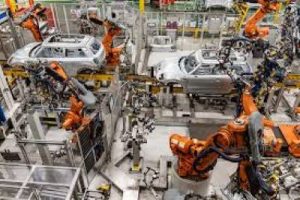Manufacturing recovery continues at a record rate

THE manufacturing sector is continuing to recover from one of the sharpest declines in living memory with new figures showing the industry enjoying record growth rates.
The latest monthly Markit/CIPS Purchasing Managers’ Index® (PMI®) shows that output for May reached 58.0 – a 15-year high for the industry – and a steady improvement on April.
Purchasing managers reported growth both in the UK domestic market and in exports, with longer supplier lead times.
The PMI has now remained above its neutral level of 50.0 for seven successive months.
The index is a vital barometer for the health of the economy. Any rating over 50 indicates that the economy is expanding while anything below 50 means that the economy is contracting.
David Noble, chief executive of the Chartered Institute of Purchasing & Supply, said: “The strength of recovery in the UK manufacturing sector has taken everyone by surprise – this time last year, the industry was on its knees.”
However, he warned the recovery could still be fragile, especially with a strengthening of sterling as pressure continued to mount on the euro.
“While the (manufacturing) turnaround so far this year is obviously good news, we can’t forget this has been driven in large part by the weak sterling exchange rate bolstering export demand,” he said.
Mr Noble said problems in countries such as Greece and Spain had strengthened the pound against the Euro recently and could also have a severe impact on the Eurozone economy.
“Given the euro countries are Britain’s biggest trading partners, any double-dip recession there would undoubtedly damage the UK manufacturing sector.
“There are also additional problems looming on the horizon which could constrain the pace of recovery. The boost from the inventory cycle will eventually wane, as firms stop balancing their stock, meanwhile the new government’s austerity measures will undoubtedly dampen the domestic market,” he added.
Despite this, he said the increase in manufacturing jobs was very good news, not just for the health of the sector, but for the UK economy as a whole.
“Higher employment means more money in the pockets of consumers which will have a positive knock-on effect on other parts of the economy and finally get us on the homerun,” he said.
Graeme Allinson, head of manufacturing, transport and logistics at Barclays Corporate, said: “UK manufacturing retains an upbeat outlook, with all statistical indicators pointing to another quarter of substantial growth.
“British producers have certainly been quick to take advantage of any glimmer of increased confidence, adjusting their business operations to mirror levels of demand and looking to target international markets.”
“It is essential for manufacturers to ensure they are not over-dependent on the government purse over the coming years however, as public spending around the world is increasingly squeezed by deficit reduction,” he added.
Ernst & Young’s influential ITEM Club said the index appeared to suggest the manufacturing sector was well on the way to recovery.
“The orders backlog and the strong growth in new orders also suggests that output will continue to rise strongly over the coming months, with quarterly output growth likely to be higher in Q2 than Q1,” it said in a statement on the latest index figures.
“The broad based nature of the upturn is also heartening because it dampens concerns that this is just a story about stocks, and suggests there is some durability to it.
“There is one note of caution – there is still some – albeit fading – discrepancy between the survey data and official figures. And other surveys such as those from the CBI suggest a more measured pace of recovery.”
It said the sector was being boosted by strong export orders, with the weak pound providing a significant boost to competitiveness.
Ernst & Young has forecast a manufacturing-led recovery for the UK economy, with strong growth expected next year and the year after as UK firms take up new opportunities in the Far East.
However, it echoed warnings about a strong pound making exports less attractive.
“As the US, Asian and Middle Eastern markets continue to pick up, we expect exports to lead the UK economy through the recovery phase. However, given the current troubles in the Eurozone, our largest trading partner, some downside risk remains.
“With the orders backlog rising, spare capacity is being soaked up, and is encouraging firms to recruit. Given the backdrop of imminent public sector job losses this is particularly encouraging, as sectors like manufacturing will need to step up to the plate to offset the public sector cuts.”








